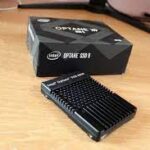Intel Optane 905P review

Last Updated on by Daniel Lawrence
Despite a wide range of excellent Solid State Drives available at affordable prices, Intel’s Optane line-up is always at the top of the list when it comes to hardcore enthusiasts.
It has proven itself to consumers who demand the best over the years, and Intel’s new Optane 905P series does little to deter that. With random read and write rates of 575,000 and 555,000 IOPS, this is one of the fastest drives we’ve tested. When compared with its predecessor, the Optane 905P achieves 25,000 more random reads and 50,000 more random writes.
With its predecessor, the Intel Optane 905P drive is available in two variants: a PCIe expansion card with RGB lighting and a 2.5-inch model. There is also a 960GB version of the 905P series, which is twice the capacity of Intel’s largest Optane 900P.
We tested the PCI-e version, which has 960GB of storage space for $1,119, while the 2.5-inch drive version comes with 480GB of storage for $599.
Design
Not only does the Intel Optane 905P SSD perform like an enthusiast’s drive, but it also looks the part. This drive measures 15mm thick, so it won’t win any awards for being the thinnest in the world, and there are very few laptops that can fit this drive. It is the kind of drive you want to show off, and is screaming to be installed in a DIY desktop setup.
Featuring a heatsink that looks like it was lifted from some sort of torture chamber, the Optane 905P is sure to please the gamer looking to build a killer-looking system.
Unlike traditional SATA drives, the power/SATA connector at the back is one large connector instead of two. As this new connector isn’t commonplace yet, Intel offers a cable that lets you connect the data part of the drive to the M.2 port on your motherboard while the power part can be plugged into a standard SATA power connector on your power supply.
Usage and Performance
A tiny little computer with high-end specs, the Zotac MBOX EN-1060, is equipped with an Intel Optane 905 Pro SSD. Since these small boxes do not have any extra power connectors, we connected the Optane 905P to the M.2 port.
We configured the Optane 905 as a secondary drive with Windows 10 running off a WD Green SSD. We installed the latest Intel drivers found on Intel’s website, which were 4.0.0.1007 dated 27th of April 2018. We benchmarked using Crystal Disk Mark 64-bit.
Intel claims sequential read and write speeds of 2,600MB/s and 2,200MB/s respectively for this drive, but those read speeds might not sound impressive compared to the Samsung 970 Evo and WD Black NVMe SSDs. However, the Optane 905 is a fast drive that performs better randomly than sequentially.
| Pros | Cons |
| Fast for random read/writes | Dimensions won’t allow laptop installations |
| Good looking | Expensive than competitors |
Conclusion
These results are slightly faster than Intel’s claimed sequential read and write speeds. More impressive are the random read and write rates, which are what make this drive so impressive.
According to my testing, the drive costs about US$599. The WD Black NVMe costs $219 for 500GB, and the Samsung 970 Evo costs about the same. We find it difficult to recommend either of these drives to anyone other than the hardcore enthusiast, as they both offer phenomenal performance for less than half the price of the Intel Optane 905P.


